As we enter the irreversible era of electric mobility, we are beginning to realize that priorities are undergoing relevant changes in what we look for in a car.
We already know that the maximum speed is being limited in many trams (some will not exceed 160 km/h) and that the engine ranges will be less extensive, making the user more concerned with autonomy and charging speed and less with horsepower and cylinders.
Even with this reality in mind, there's no denying that the new high-end star brand divides its target clientele. Some look to the Mercedes-Benz EQS as the logical step to enter this new world, others find it difficult to live with the so-called “arc” design, complaining that it lacks the grandeur that has always been recognized in the style of the various S-Class over the decades.
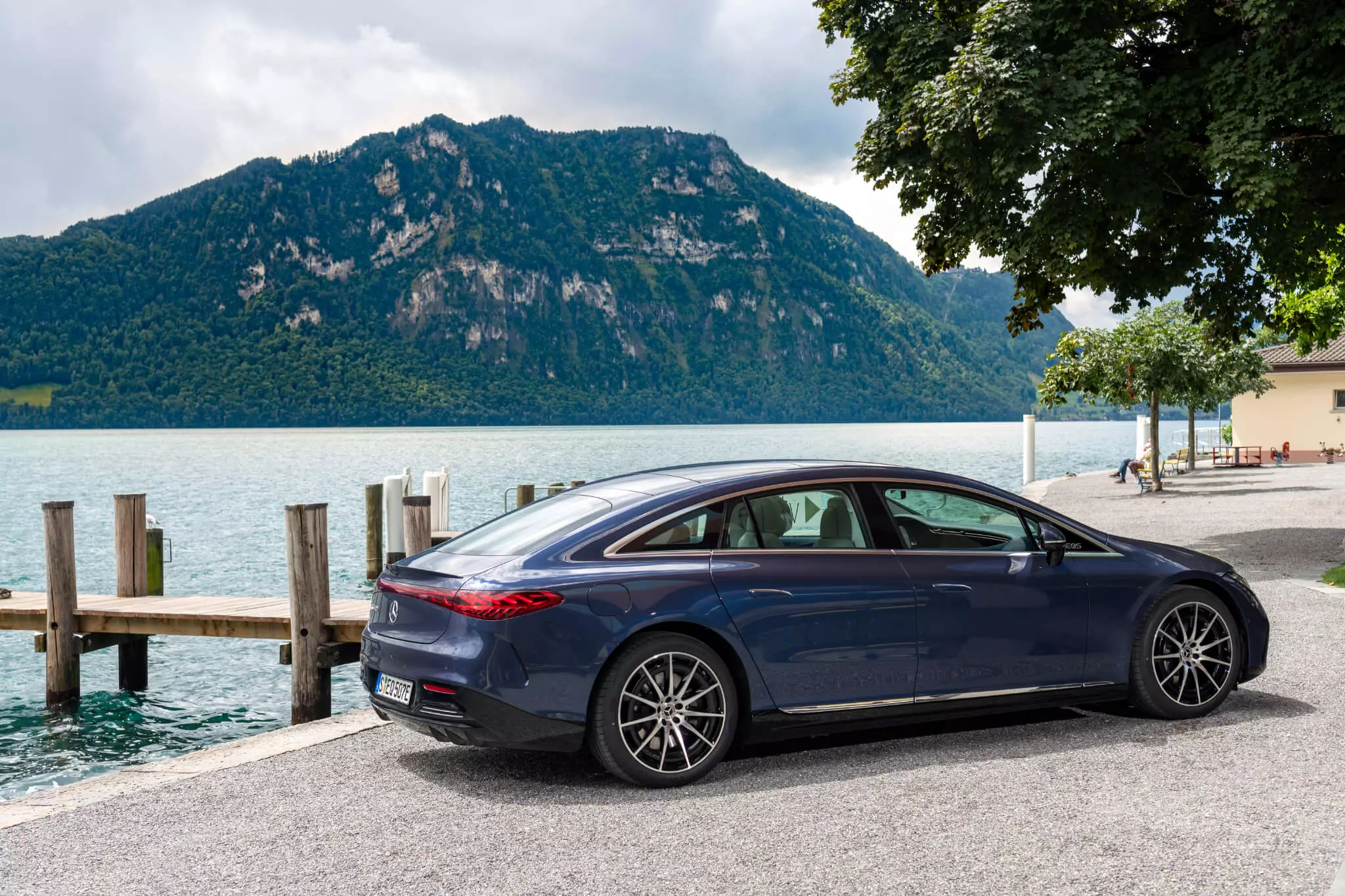
But there is no big turnaround in terms of design because the fight is made against every tenth you can win in terms of aerodynamic coefficient, in which the EQS is the absolute world record among luxury saloons (Cx of 0.20 improved the previous world record, which was for the new S-Class, with 0.22). All so that the autonomy levels are very close to those achieved with a full tank by models of similar size, but with combustion engines.
Wide cabin, raised seats
One of the well-known advantages of the specific architectures of electric cars is the huge and unobstructed interior space, as well as a large luggage compartment (in this case, 610 l that can be expanded to 1770 l if the rear seat backs are folded down).
Inside, the positive impact of the architecture is clearly felt in the clear space both in the center console area (which doesn't need to have a bulging central tunnel covering the non-existent gearbox) and, mainly, in the second row of seats, where the occupants have legroom to give and sell and the occupant of the central place has freedom of movement because the usual obstruction caused by the transmission tunnel does not exist.

Oliver Rocker, chief engineer at EQS, explains to me that “the occupants sit 5 cm taller than in the S-Class because the battery (which is quite thin) is mounted on the floor and the roof is also taller (such like the waistline), but it is only marginally taller than the S”.
access step
As an access step to the EQS range, the 450+, with 245 kW (333 hp) and 568 Nm, does not have to be considered a much more limited choice compared to the 580 4MATIC+ (385 kW or 523 hp and 855 Nm), the first of the EQS we were able to conduct:
It is true that it does not have four drive wheels (in Portugal this is less important when compared to countries where it rains and snows most of the year), because it only uses an electric motor, in the rear, which ends up consuming less energy than the two. that make the 580 move.
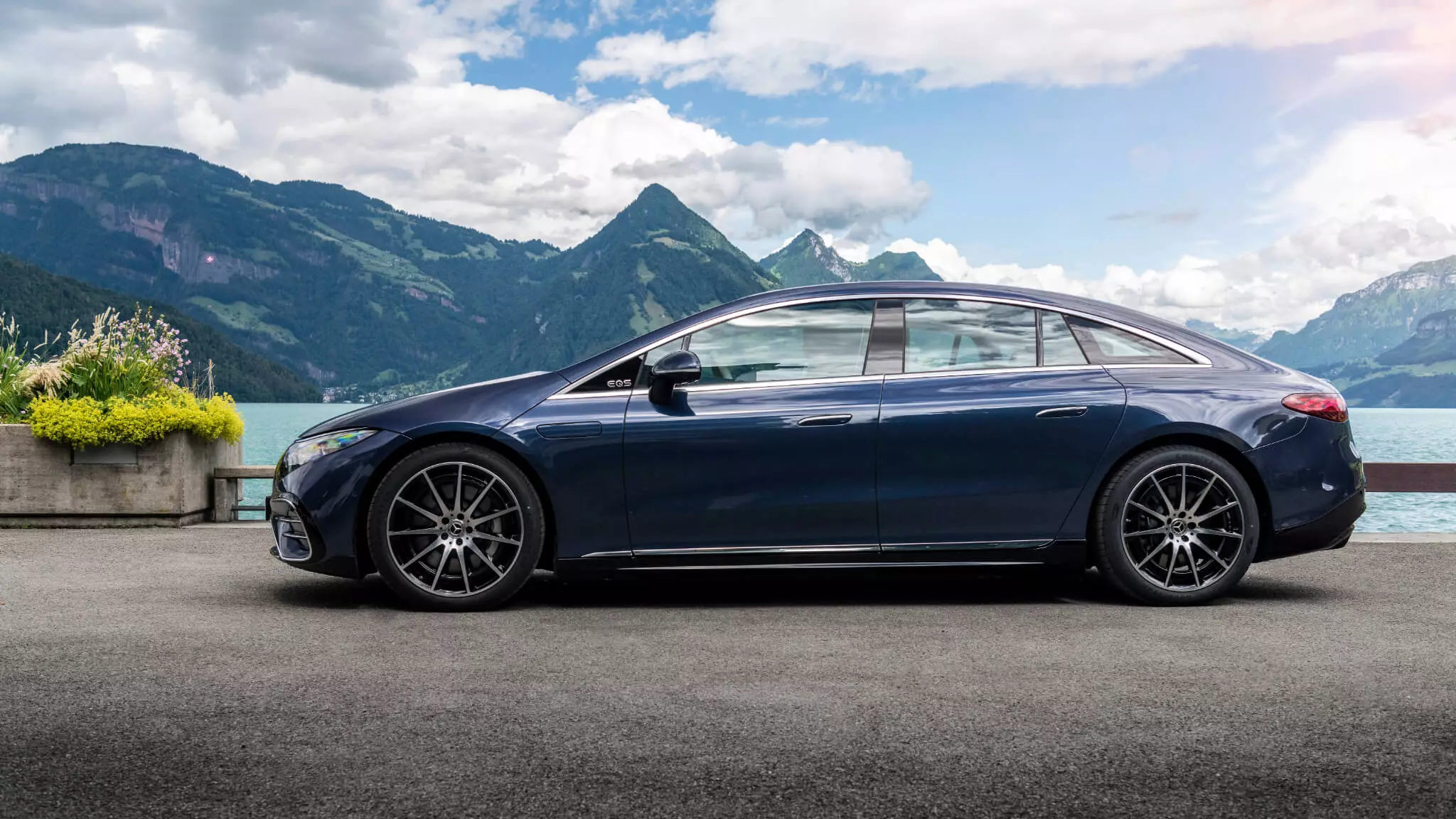
The result, with the same 107.8 kWh battery, is a good additional 100 km of autonomy (780 km vs. 672 km), with the top speed being equal (210 km/h) and the accelerations being slower, of course, but still worthy of sports cars (6.2s from 0 to 100 km/h, even though the 580 is capable of doing it in a “semi-insane” 4.3s).
And, no less interesting, with a price nearly 28 thousand euros lower (121,550 euros for the 450 against 149,300 for the 580).
And if we compare it with the S-Class?
If we make the comparison with the S-Class, the EQS only exists with one wheelbase (against three of the “cousin” combustion), the very distinguished rear passengers sit in a higher position. On the other hand, it is not possible to have something like the individual “armchairs” of the S-Class, with all the electrical adjustments, which is also true for the side and rear curtains.

Some of the lost glamor can be regained with the door that opens automatically when the driver approaches the car, duly armed with his key, then closes by itself when I sit down and apply the brake. The same happens when any of the occupants put their hand close to the interior handle of their door and as long as the movement is not aborted because there is some obstacle - human or material - outside, in order to avoid unwanted contact.
Hyperscreen, the lord of screens
And, speaking of scenic effects, what about the Hyperscreen dashboard (optional, but mounted on the guided unit) that immediately takes us back to a Star Wars context?
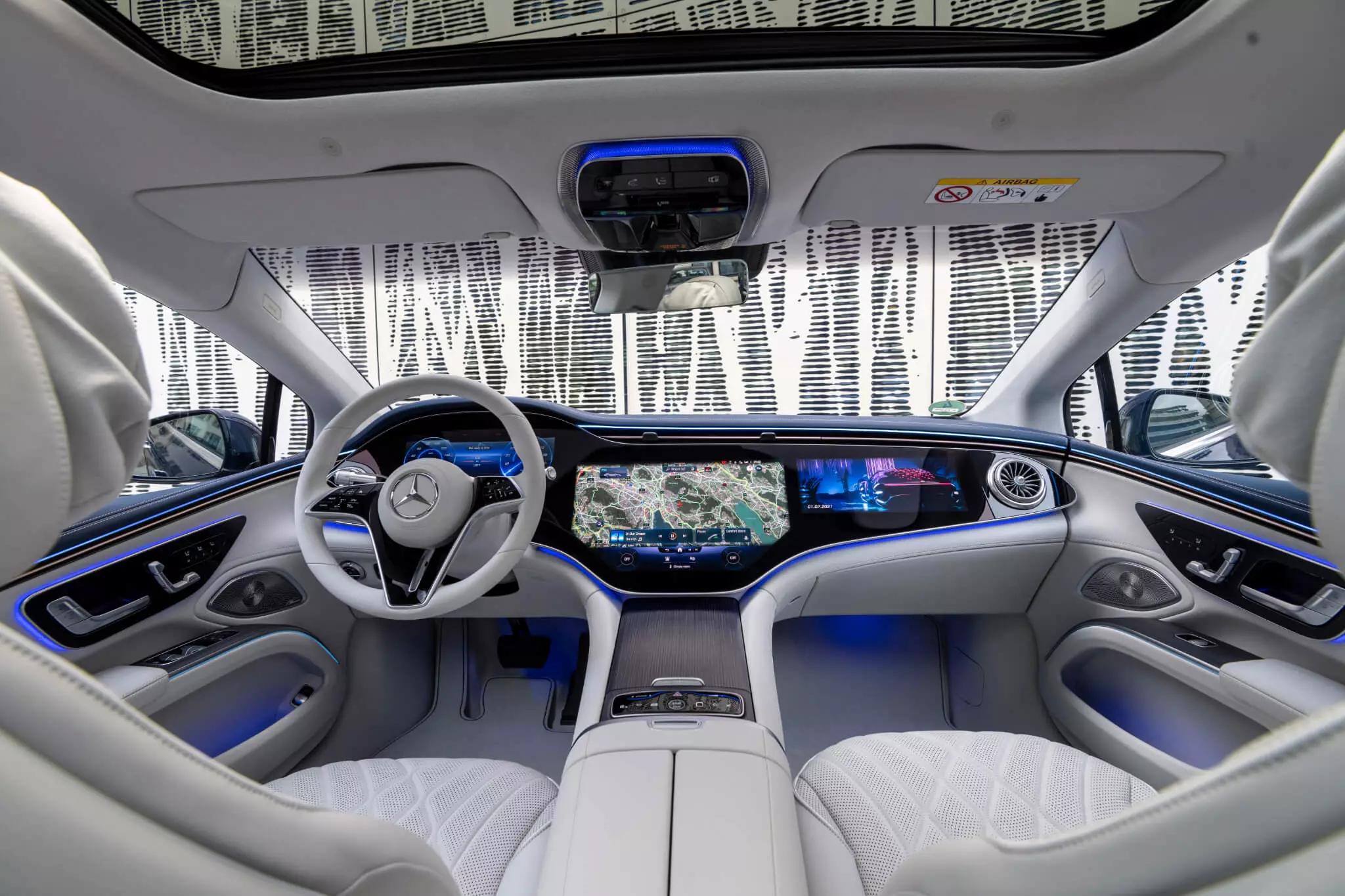
It's the largest (1.41 m wide) and smartest glass dashboard ever mounted in a car, with three independent screens (instrumentation 12.3", central 17.7" and passenger's 12.3” front, these two brighter for being OLED) under a slightly curved surface that appears to be a unique interface.
Information is projected or hidden in the background by itself, according to what the user learns from the user, and voice commands and gestures are added to this experience. An example: the brightness of the information that has just been requested increases and then, with the help of the camera, you can dim the co-driver's screen for the driver, so that when he directs his gaze to that screen he will not be able to see the image (but the copilot does).
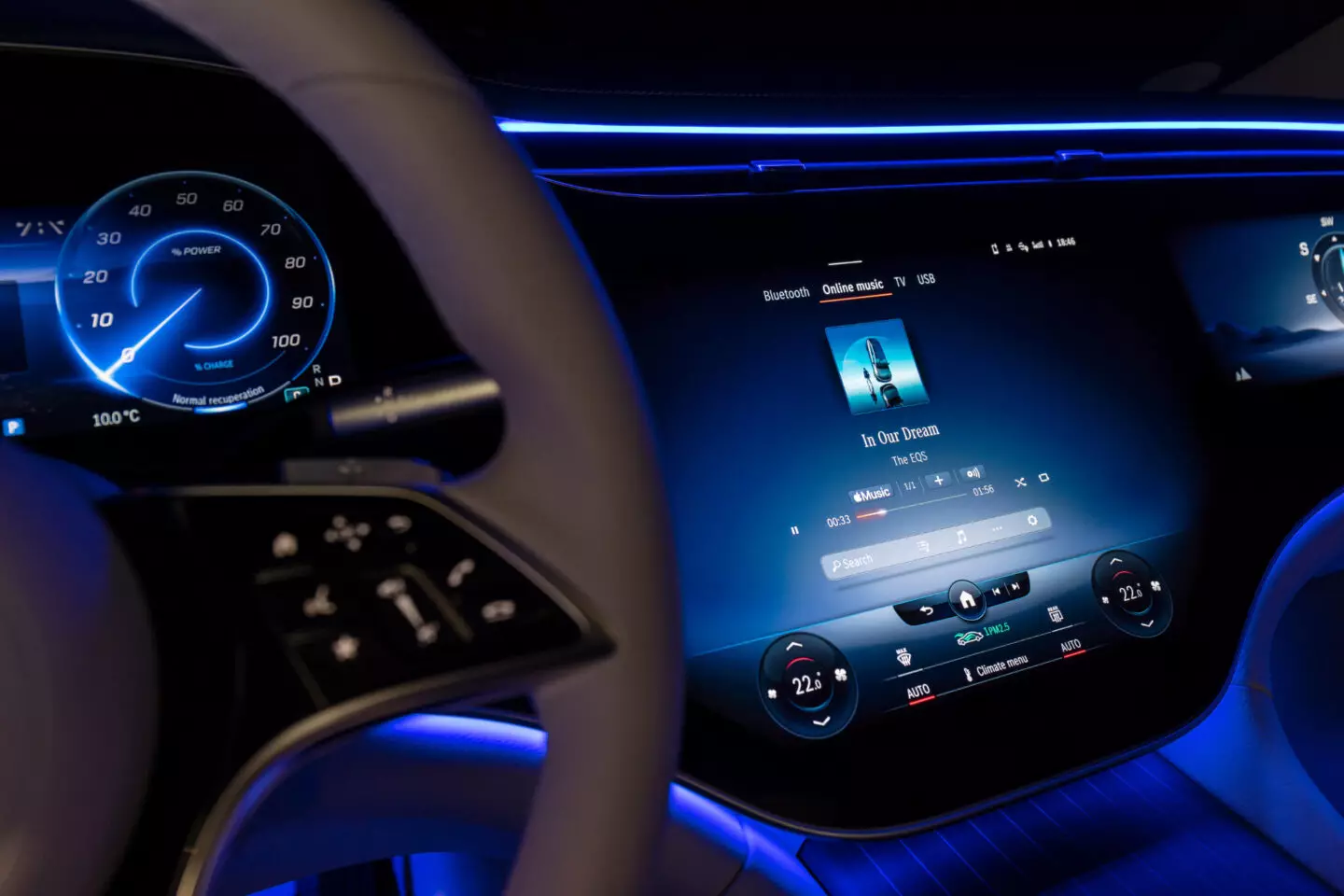
Even with all the care taken to leave the most used information right in front of the driver's eyes and to minimize the time spent searching for data, I realize that it is very important to dedicate some time to parameterizing and customizing the screens as much as possible (central, instrumentation and the head-up display) before starting the trip, to avoid that the same information is repeated twice or more or that this redundancy is taking up unduly space.
When in motion, the glazed mega dashboard reveals all its usefulness with a favorable and an upgradeable point: fingerprints are less marked on its surface than on most touch screens I've used, but the one in front of the front passenger has little use.
More than 700 km of autonomy
There are two battery sizes/capacities, the “smallest” with 90 kWh (bag cells and 10 modules) and the largest (mounted in this unit) with 107.8 kWh (prismatic cells and 12 modules) and the confidence of Mercedes- Benz in its longevity is such that it offers a factory warranty of 10 years or 250 000 km (becoming the longest on the market, because the normal is eight years/160 000 km).
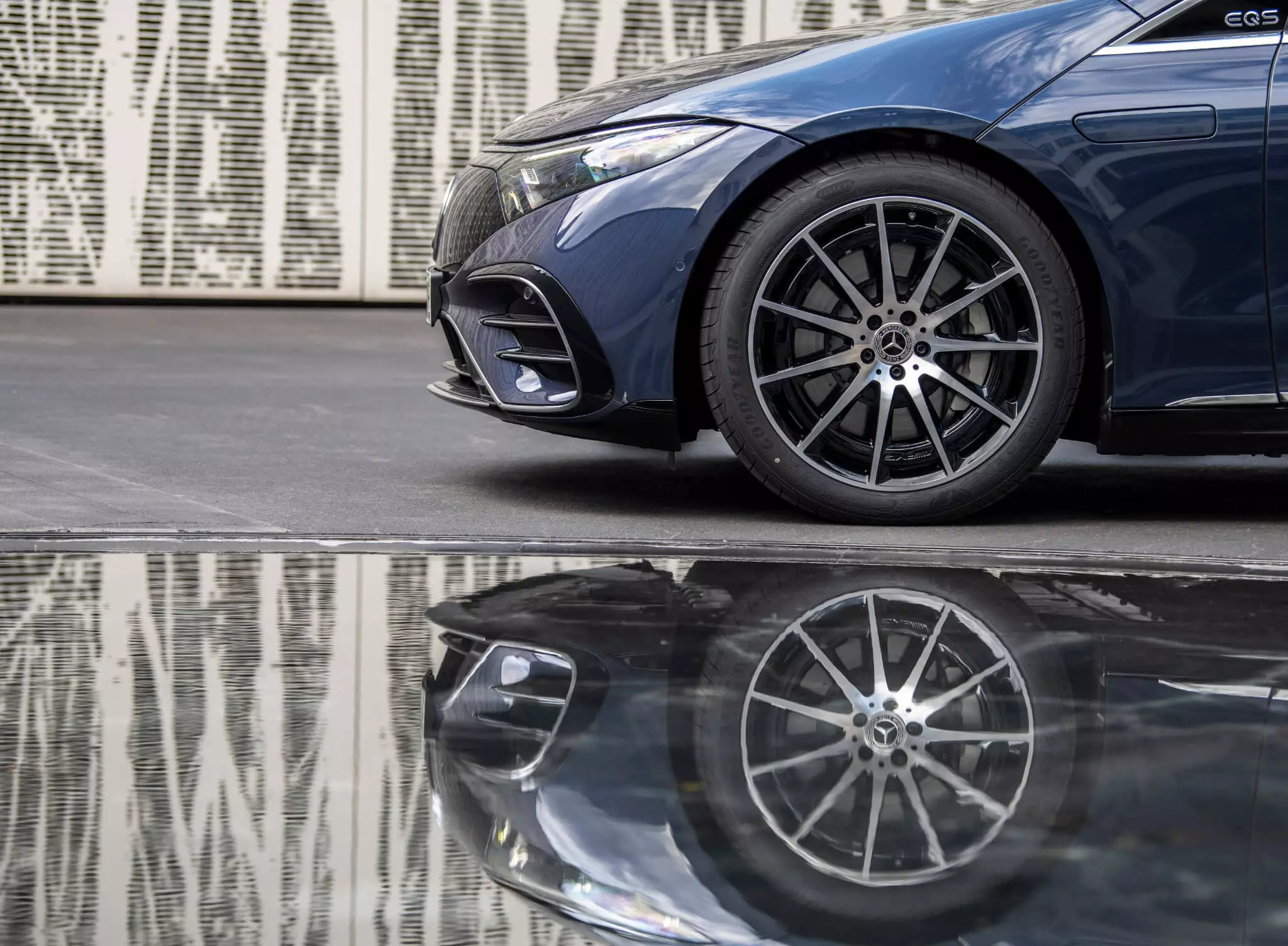
Comparing the 450+ with the 580 again, it is natural that the second achieves a higher energy recovery by braking/deceleration by having two engines, but, in compensation, the lower consumption of the rear-wheel-drive EQS (16.7 kW/ 100 km against 18.5 kWh/100 km) also means that in just 15 minutes at an ultra-fast charging station, the 450 can receive enough energy for 300 km, against 280 km in the more powerful version.
Of course, at less powerful charging points on alternating current (AC) — Wallbox or public stations — much longer times will be needed: 10 to 100% in 10 hours charging at 11 kW (standard) or five hours at 22 kW ( which is the power of the optional on-board charger).

The energy recovery levels themselves can be managed by the paddles behind the steering wheel to select one of three levels (D+, D and D-) or else leave it in D Auto for the car to manage it by itself (in this program you can if a maximum deceleration of 5 m/s2, three of which by recovery and two by hydraulic braking).
At the maximum level of recovery it is possible to drive with just one pedal, the car being able to come to a complete stop without using the brake. The Eco assistant is used to optimize energy recovery in advance, taking into account the topography, traffic, climate and with the help of the navigation system.
on the road
The first experience behind the wheel of the EQS 450+ took place in Switzerland and confirmed the promised attributes. The rolling characteristics are different from those of the S-Class: the air suspension makes the floor under the car appear to be smoothed as you go, but with a firmer step (this happens due to the weight of the batteries, which reaches 700 kg in this version ), which adds a fun note to driving.
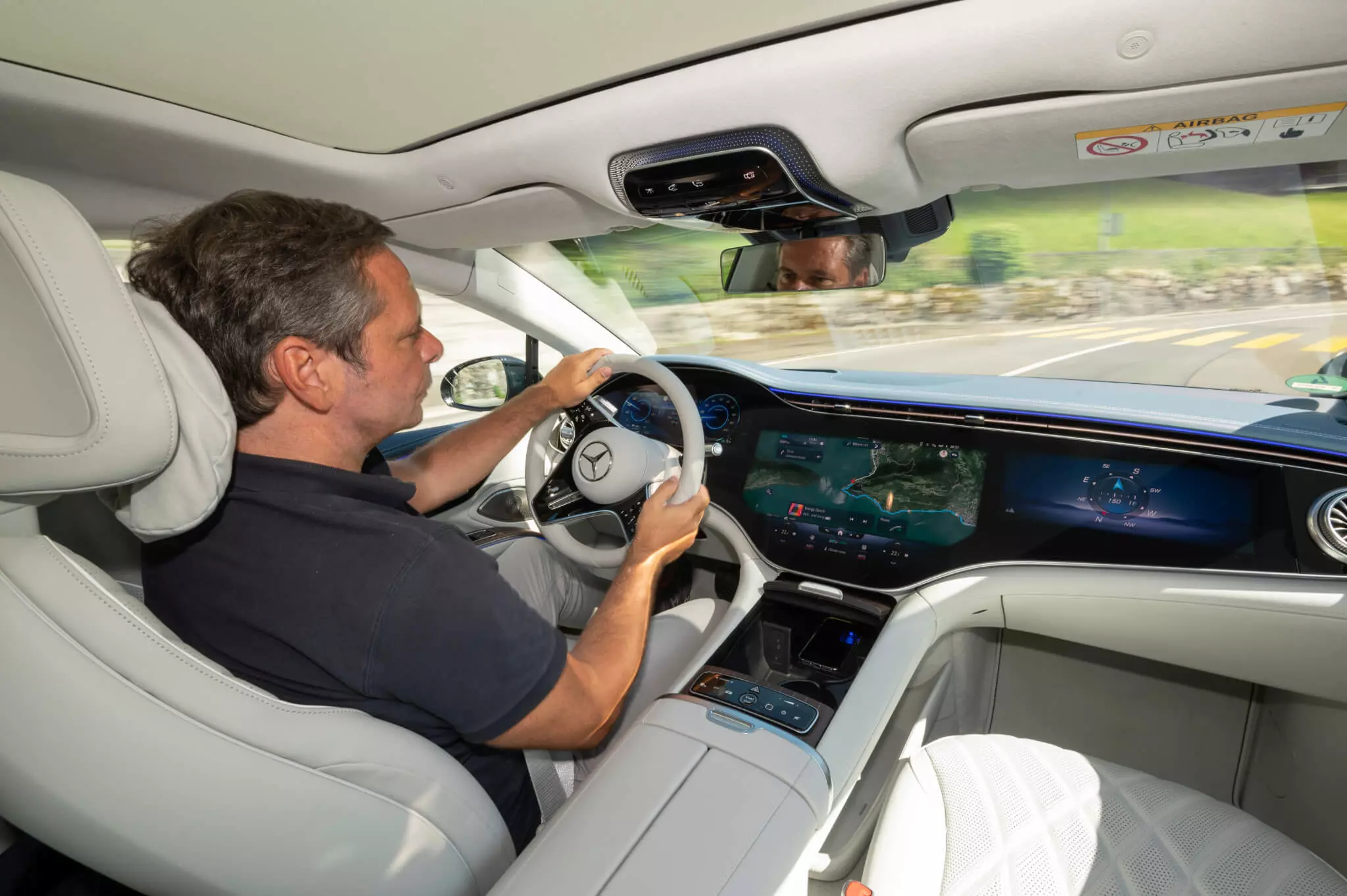
The front wheels are linked by four arms and the rear by a multi-arm system, with air suspension and electronic shock absorbers with continuously variable response and individually adjustable on each wheel, both in compression and extension.
The suspension manages to maintain the same height to the ground regardless of the load being carried, but it also implements intentional variations. Examples: in Comfort mode (the others are Sport, Eco and Individual) the bodywork drops by 10 mm above 120 km/h, and by another amount above 160 km/h, always to reduce aerodynamic resistance and favor stability.
But below 80 km/h the vehicle climbs back to its normal position; up to 40 km/h the bodywork can be lifted 25 mm at the touch of a button and automatically lowers to the starting position when reaching 50 km/h.
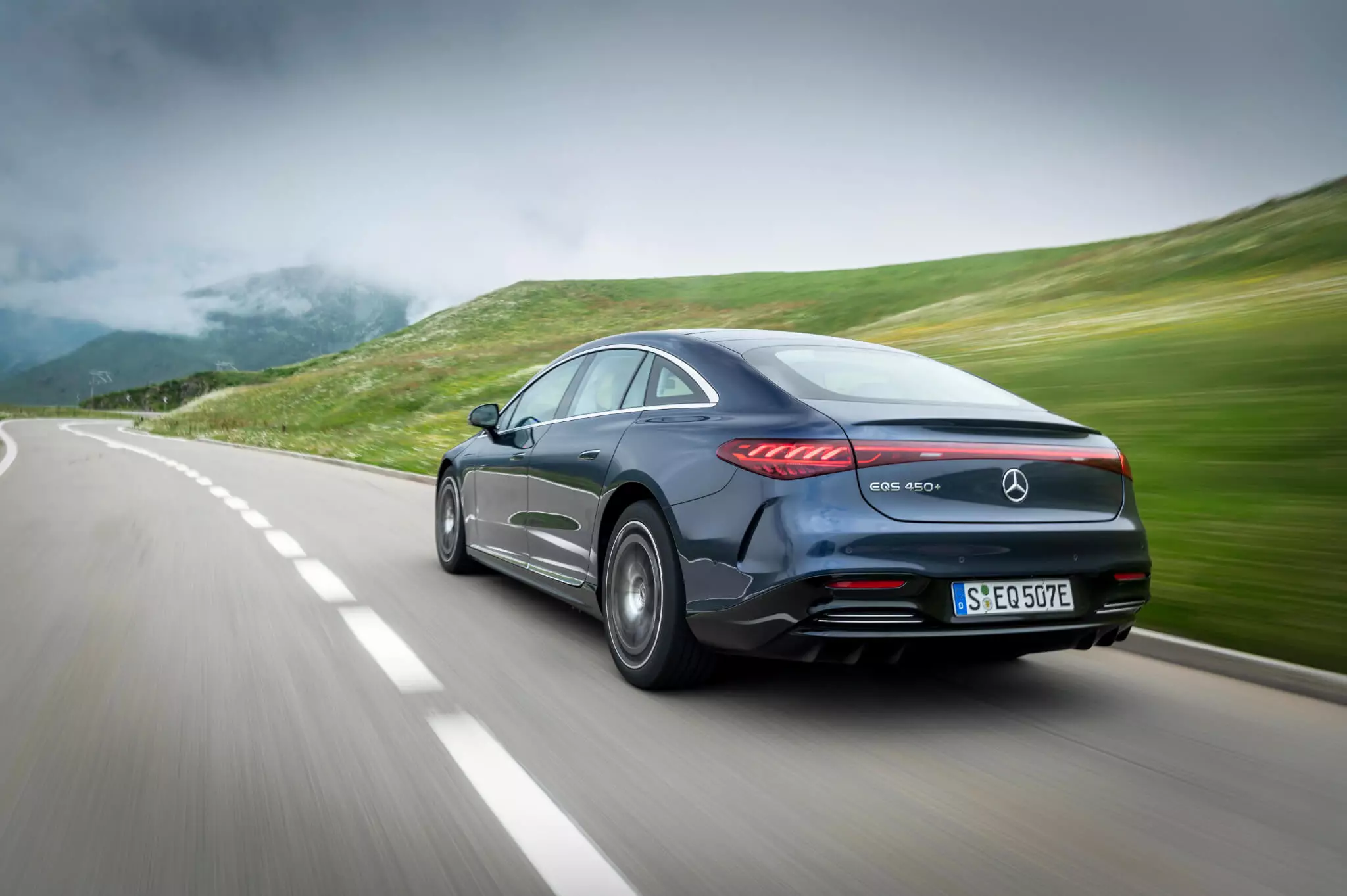
Important is also the fact that the rear axle is directional, the wheels being able to turn 4.5º (standard) or 10º (optional) in the opposite direction to the front ones, in the latter case allowing a turning diameter of only 10.9 m (less than than a Class A) to which a steering wheel is added, tends to be light with only 2.1 end-to-end laps. As usual in these systems, from 60 km/h onwards, they turn in the same direction as the front, to favor stability.
The soundproofing of the cabin is sensational and I frankly like to enjoy the silence more than turning on any of the three “soundtracks” available and which, fortunately, are only heard inside the EQS (only the discreet presence sound required by law outside): the Silver Waves sounds like a spaceship, the Vivid Flux too, but with more futuristic frequencies and the (optional) Roaring Pulse sounds like a mix of the sound of an AMG V12 engine and the grunting of a bear with a bad mood and digestion problems.
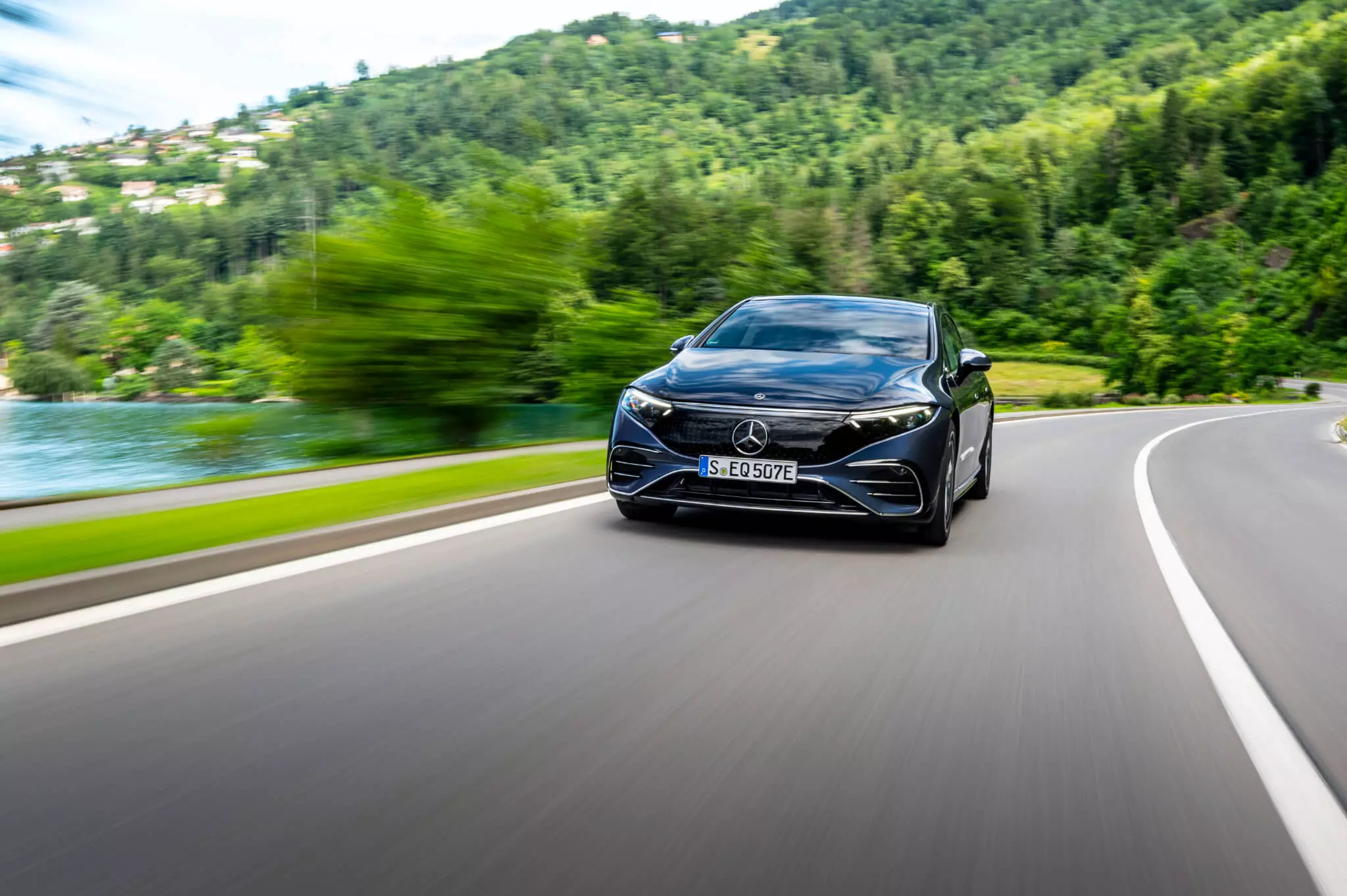
The electric motor's immediate response doesn't take almost anyone by surprise these days, but with this level of performance the sports car's performance always causes some incredulity in a car of more than 5 m in length and weighing 2.5 tons.
German drivers can exorcise demons at unlimited speeds on many of their country's highways and the fact that the EQS' top speed is 210 km/h shouldn't bother many potential customers (only the Mercedes-AMG EQS 53 will have free rein up to 250 km /H). That is, more than electrified Volvos and less than Tesla Model S, Porsche Taycan and Audi e-tron GT.
Discover your next car:
moderate appetite
Of course, at these rates you can't match the autonomy promised by the German brand, but the first indications collected in this test are very positive and clearly benefit from such refined aerodynamics that we praised at the beginning.
In 94 km of a balanced mix of city, secondary roads and highway, in fluid rhythms following the cadence of the highly regulated and monitored Swiss traffic, but without looking for consumption records, I ended up with an average of 15.7 kWh/100 km, less than the officially announced value. If it is not unprecedented, it is at least very rare for something like this to happen, but it allows us to believe that the 780 km of autonomy of this version will be possible on a daily basis.
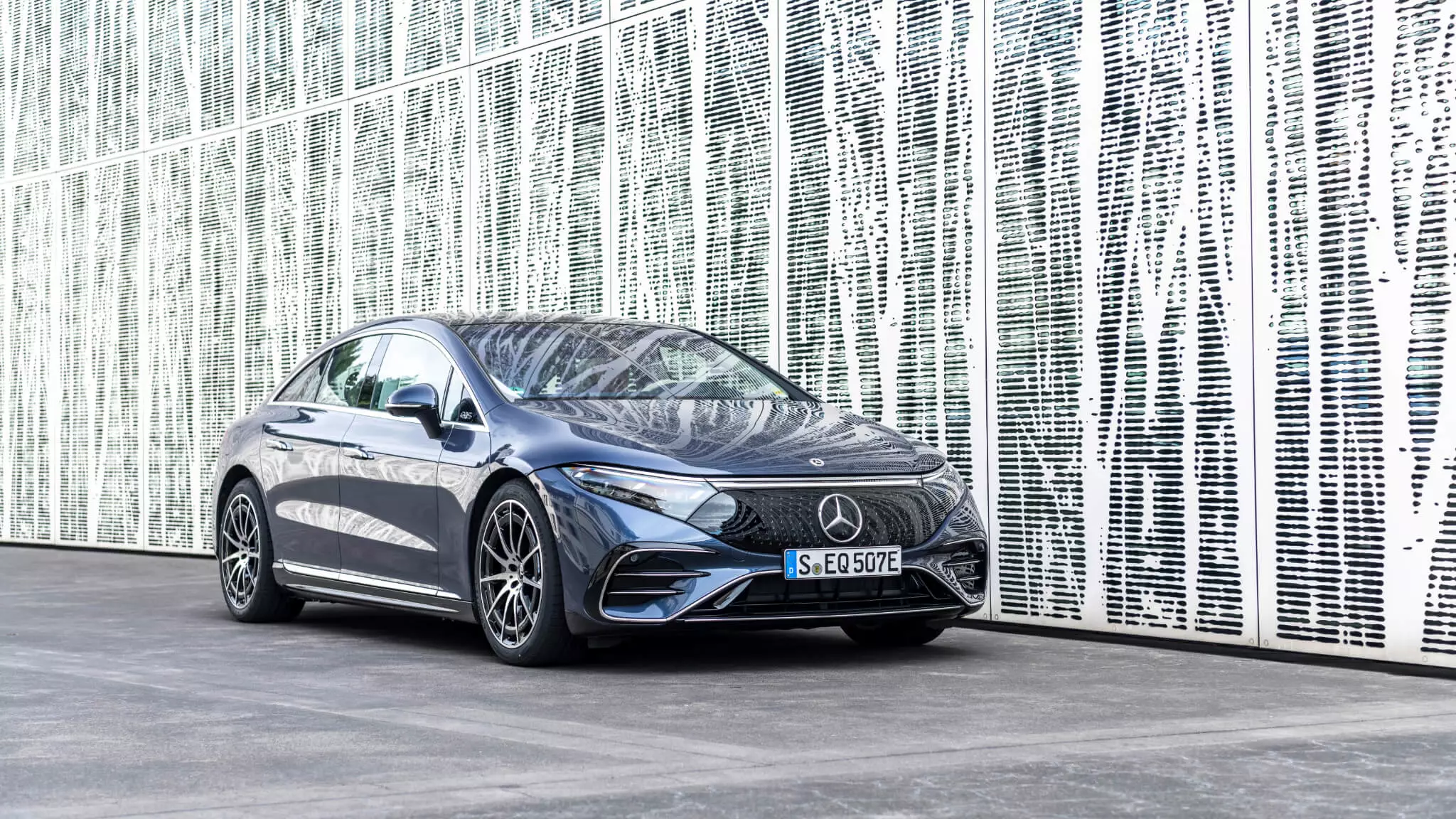
Technical specifications
| Mercedes-Benz EQS 450+ | |
|---|---|
| Motor | |
| Motor | Electric motor on rear axle |
| power | 245 kW (333 hp) |
| Binary | 568 Nm |
| Streaming | |
| Traction | back |
| Gear box | Reduction box of a relationship |
| Drums | |
| Type | lithium ions |
| Capacity | 107.8 kWh |
| Loading | |
| ship loader | 11 kW (optional 22 kW) |
| Maximum power in DC | 200 kW |
| Maximum power in AC | 11 kW (single-phase) / 22 kW (three-phase) |
| loading times | |
| 0 to 100% in AC | 11 kW: 10h; 22 kW: 5h |
| 0 to 80% in DC (200 kW) | 31 min |
| Chassis | |
| Suspension | FR: Independent double overlapping triangles; TR: Independent multiarm; Pneumatic suspension |
| brakes | FR: Ventilated discs; TR:m Ventilated Discs |
| Direction | electrical assistance |
| turning diameter | 11.9 m (10.9 m with 10º directional rear axle) |
| Dimensions and Capabilities | |
| Comp. x Width x Alt. | 5.216 m/1.926 m/1.512 m |
| Length between the axis | 3.21 m |
| suitcase capacity | 610-1770 l |
| Tires | 255/45 R20 |
| Weight | 2480 kg |
| Provisions and consumption | |
| Maximum speed | 210 km/h |
| 0-100 km/h | 6.2s |
| Combined consumption | 16.7 kWh/100 km |
| Autonomy | 631-784 km |
